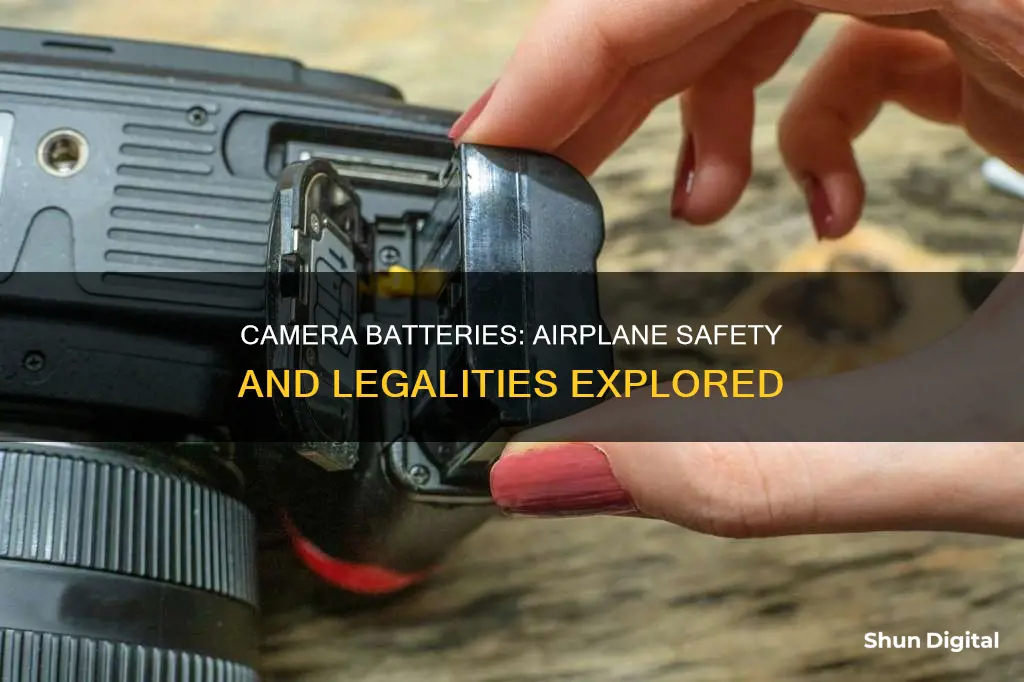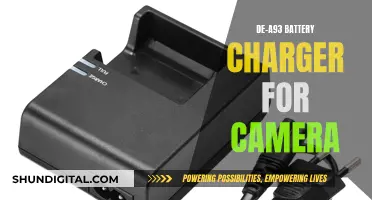
Camera batteries are not illegal on airplanes, but there are strict regulations for carrying them on board. Most standard dry cell alkaline batteries such as AA, AAA, C, and D can be freely taken on board without restrictions. However, lithium-ion batteries, which are commonly found in camera equipment, have specific rules due to their potential for rapid combustion. These batteries must be carried in hand luggage and are subject to watt-hour and weight restrictions. It is also important to protect the battery terminals and ensure they don't come into contact with metal objects to prevent short circuits.
| Characteristics | Values |
|---|---|
| Type of batteries allowed | Standard dry cell alkaline batteries (AA, AAA, C, and D) and lithium-ion batteries |
| Where to keep the batteries | Carry-on baggage |
| Quantity | No restriction on the number of standard dry cell alkaline batteries. Two spare lithium-ion batteries are allowed. |
| Weight/Watt-hour limit | 2 grams of lithium per battery for lithium metal batteries and 100-watt hours per battery for lithium-ion batteries |
| Protection | Battery terminals should be protected to prevent short circuits. |
What You'll Learn
- Lithium-ion camera batteries are allowed on planes if they are under 100Wh
- Lithium-ion camera batteries over 100Wh may need prior airline approval
- Lithium-ion camera batteries must be protected from damage and short circuits
- Lithium-ion camera batteries must be carried in hand luggage
- Lithium-ion camera batteries are limited to two per person

Lithium-ion camera batteries are allowed on planes if they are under 100Wh
When it comes to lithium-ion camera batteries, it's important to be aware of the regulations to ensure safe air travel. The good news is that these batteries are typically allowed on planes as long as they meet certain criteria. Here's what you need to know:
Watt-Hour Rating:
The key factor in determining whether your lithium-ion camera batteries are permitted on a plane is their watt-hour (Wh) rating. If your batteries fall below 100Wh, you're generally allowed to bring them on board without any issues. This threshold covers most standard camera batteries, giving you peace of mind during travel.
Installed vs. Spare Batteries:
The regulations for installed and spare lithium-ion batteries differ slightly. Installed batteries refer to those that are already placed inside your camera or other electronic devices, such as smartphones, laptops, or tablets. These installed batteries are generally considered safe and can be carried in your carry-on baggage. However, if you need to pack your camera with installed batteries in checked luggage, it's recommended to turn the devices off, prevent accidental activation, and pack them securely to avoid damage.
On the other hand, spare lithium-ion batteries, which are not installed in any device, should always be carried in your carry-on baggage. Keeping them with you in the cabin is crucial because, in the unlikely event of a fire, it can be promptly addressed by the cabin crew and passengers. Leaving spare lithium-ion batteries in the cargo hold without easy access can pose a significant safety risk.
Quantity and Weight Limits:
When travelling with lithium-ion camera batteries, it's important to be mindful of any quantity and weight restrictions. While there is no limit on the number of batteries below 100Wh, it's essential to ensure that you don't exceed the overall weight limit for carry-on baggage. Additionally, if you need to bring spare batteries between 101 and 160Wh, you can typically carry up to two of them, but it's advisable to check with your airline beforehand to obtain their approval.
Battery Protection:
To ensure the safety of your lithium-ion camera batteries during air travel, it's crucial to take the necessary precautions. Make sure to protect the battery terminals by using the manufacturer's packaging or covering them with tape. This measure helps prevent short circuits, reducing the risk of sparks or overheating. Additionally, consider placing each battery in a separate bag for added protection and to avoid accidental contact with metal objects.
In summary, lithium-ion camera batteries under 100Wh are generally allowed on planes, but it's important to follow the guidelines for installed and spare batteries, respect weight and quantity limits, and take the necessary precautions to protect your batteries during travel. By staying informed and prepared, you can confidently navigate air travel with your camera equipment and capture memorable moments on your journey.
Trail Camera Battery Life: How Long Do They Last?
You may want to see also

Lithium-ion camera batteries over 100Wh may need prior airline approval
Camera equipment often relies on lithium-ion batteries, which are allowed on airplanes but with some restrictions. The US Federal Aviation Administration (FAA) and the European Union Aviation Safety Agency (EASA) enforce specific rules to ensure the safety of flights.
Lithium-ion batteries, with their potential for rapid combustion, are subject to regulations. While installed lithium-ion batteries in devices like cameras are generally considered safe, uninstalled or spare batteries require special handling. These uninstalled batteries must be carried in your carry-on baggage, as a fire in the cabin can be more easily addressed by the crew than one in the cargo hold.
When it comes to power ratings, the FAA and TSA provide guidelines. Lithium-ion batteries below 100-watt hours (Wh) are typically permitted without issue. However, if you plan to travel with lithium-ion camera batteries exceeding 100Wh, prior approval from the airline may be necessary. With their consent, passengers may carry up to two spare lithium-ion batteries ranging from 101-160Wh.
To obtain approval for larger lithium-ion camera batteries, it is advisable to contact your airline in advance. They can provide specific instructions and ensure you comply with their policies. Additionally, remember to protect the battery terminals from short circuits by using the original packaging or covering the terminals with tape.
Charging the Black Magic Camera: A Step-by-Step Guide
You may want to see also

Lithium-ion camera batteries must be protected from damage and short circuits
Lithium-ion batteries are widely used in many electrical devices, including cameras. While they are convenient due to their rechargeability, they can become dangerous if not properly protected. Lithium-ion batteries have the potential for rapid combustion, and a short circuit can lead to a dangerous chain reaction of toxic-fume emission, fire, and even explosion. Therefore, it is crucial to take the necessary precautions to protect lithium-ion camera batteries from damage and short circuits when travelling by airplane.
Firstly, it is important to use the correct packaging to protect the batteries. Each battery or battery-powered device should be packed in fully enclosed inner packaging made of non-conductive material, such as a plastic bag. This will prevent contact with other batteries, devices, or conductive materials that could cause a short circuit. Additionally, ensure that any exposed terminals or connectors are protected with non-conductive caps or tape. This will prevent accidental contact with conductive materials and reduce the risk of a short circuit.
It is also crucial to protect the battery terminals from damage. This can be done by securely attaching covers over the terminals with sufficient strength to withstand impact. Constructing the battery with recessed terminals can also help to prevent damage if the package is dropped. The outer packaging should not be relied upon as the sole means of protecting the battery terminals unless it is impact-resistant.
To further safeguard against short circuits, batteries should be securely cushioned and packed to prevent shifting during transport. This will help to ensure that the battery terminals remain intact and do not come into contact with other conductive materials. It is also recommended to place batteries in separate bags to provide an additional layer of protection.
Another important precaution is to avoid overcharging the batteries. Lithium-ion batteries should not be charged above 4.30V, and a temperature rise of more than 10ºC during charging indicates a potential problem. Additionally, it is essential to only use lithium-ion batteries with a designated protection circuit and approved charger. This will help to prevent overcharging and reduce the risk of a short circuit.
By following these precautions, you can help ensure that your lithium-ion camera batteries are protected from damage and short circuits during air travel, reducing the risk of dangerous incidents.
Charging the Kitmesh Camera: A Quick Guide
You may want to see also

Lithium-ion camera batteries must be carried in hand luggage
Camera batteries are an essential component of your travel kit, but it's important to understand the rules around flying with them. Most camera batteries are lithium-ion batteries, and there are specific regulations enforced by aviation authorities worldwide, like the FAA or EASA, to ensure the safety of flights. So, what's the deal with lithium-ion camera batteries?
Now, let's dive into the specifics. When packing lithium-ion camera batteries for air travel, there are a few key things to keep in mind. First, make sure the batteries are in good condition with no signs of swelling or damage. Second, protect the battery terminals by using the manufacturer's packaging or covering them with tape to prevent short circuits. Third, place each battery in a separate bag for added protection. These simple steps will help ensure a smooth travel experience.
Additionally, it's important to note that there are limits to the number and wattage of lithium-ion batteries you can carry. You are typically allowed to bring two large lithium-ion batteries with a watt-hour (Wh) rating between 101 and 160 Wh. For batteries below 100 Wh, there is usually no limit, but it's always good to check with your airline. These regulations are in place to ensure the safe transport of lithium-ion batteries, so be sure to follow them closely.
In summary, when travelling with lithium-ion camera batteries, always carry them in your hand luggage. By taking the necessary precautions and following the guidelines, you can ensure a hassle-free journey and focus on capturing memorable moments with your camera.
Charging Your Camera in Europe: What You Need to Know
You may want to see also

Lithium-ion camera batteries are limited to two per person
Lithium-ion batteries, which are commonly found in cameras, smartphones, laptops, and tablets, are considered safe if they are installed inside the device. However, aviation authorities such as the FAA and EASA enforce specific rules to ensure flight safety due to the recognised risk of rapid combustion associated with lithium-ion technology.
When it comes to lithium-ion camera batteries, there are important regulations to follow. Firstly, it is recommended to keep these batteries in your carry-on baggage. This is because, in the event of a fire, it can be addressed by the cabin crew and passengers inside the aircraft cabin. Placing lithium-ion batteries in checked baggage is generally not advised, as any fire incidents in the cargo hold could be more challenging to manage without immediate intervention.
To comply with aviation safety regulations, passengers are typically allowed to carry up to two spare lithium-ion batteries with them on the plane. These batteries should have a watt-hour rating between 101 and 160 Wh. It is important to note that the batteries should be protected from damage and accidental activation, as per the guidelines provided by the US Federal Aviation Administration (FAA). Additionally, covering the battery terminals with tape or using the manufacturer's packaging can help prevent short circuits.
It is also worth noting that damaged, defective, or recalled lithium batteries are not permitted in carry-on or checked baggage if they pose a safety concern by potentially overheating or catching fire. Therefore, it is crucial to ensure that your lithium-ion camera batteries are in proper condition before packing them for air travel.
Charging Camera Batteries: Do They Need a Full First Charge?
You may want to see also
Frequently asked questions
Camera batteries are allowed on an airplane, but there are specific rules in place to ensure safety.
Lithium-ion camera batteries are typically allowed in carry-on luggage, but they must be protected from damage and short circuits. Each passenger is limited to two spare batteries.
Yes, lithium-ion camera batteries within 100Wh are generally permitted in carry-on luggage. Larger batteries may require approval from the airline.
It is recommended to cover the battery terminals with tape or store them in their original packaging to prevent short circuits. Keep them in a separate bag and always carry them in your carry-on luggage.







